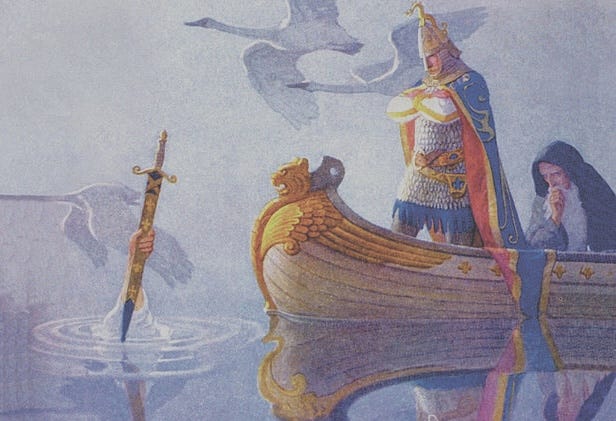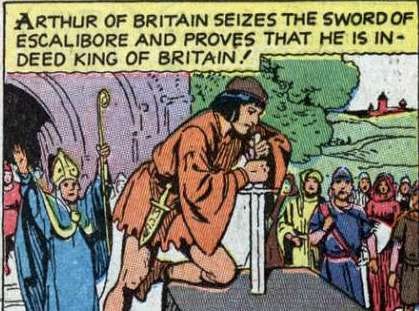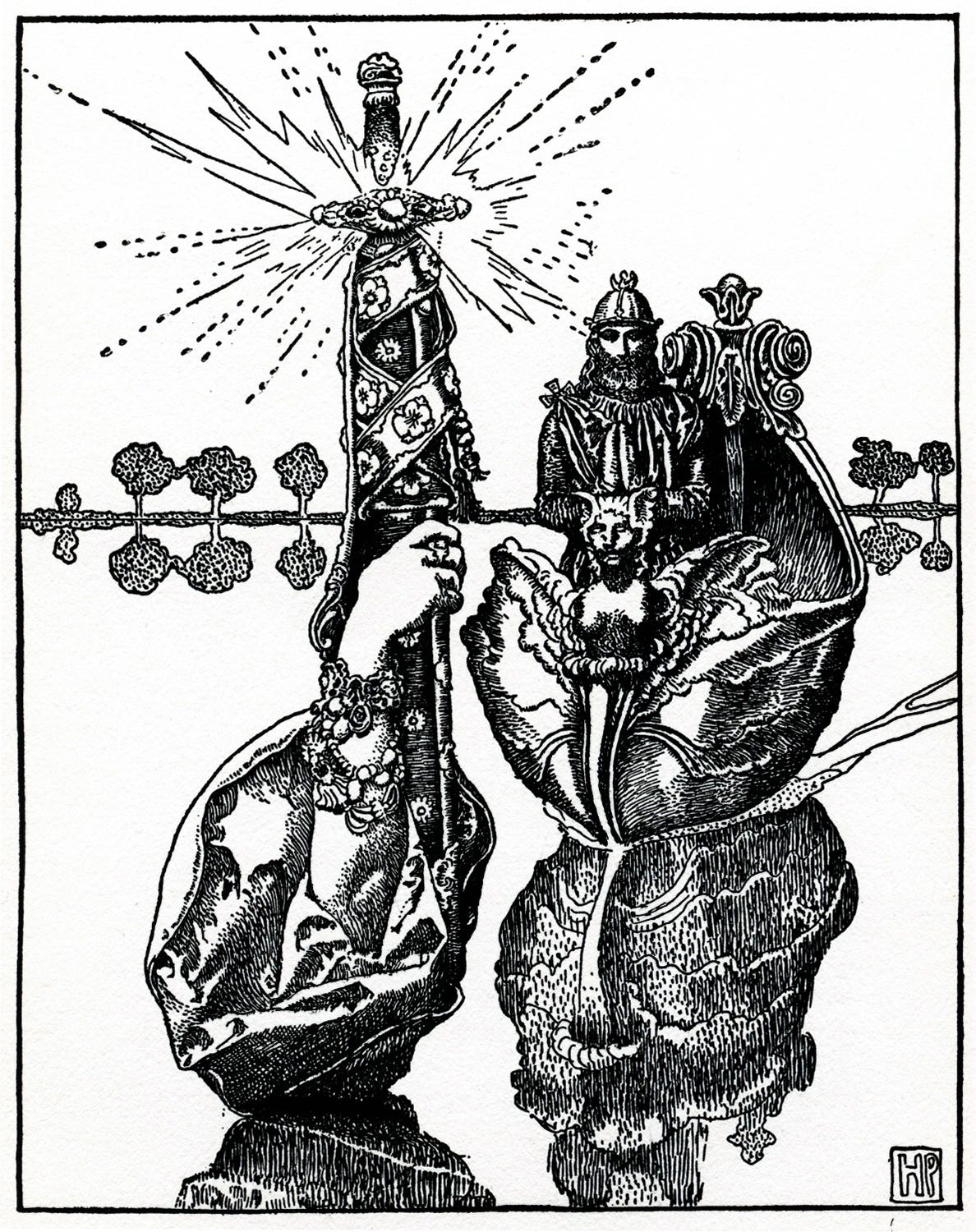Let’s talk about Excalibur for a second. Because it’s cool but also a little odd.
To start with Excalibur proliferates virulently. It’s everywhere—it’s at least as well-traveled as its famous owner, cf my earlier note on Arthur’s tendency to get upstaged. There’s an Excalibur in Doctor Who and Assassin’s Creed and Yu-Gi-Oh! My son has a Beyblade called Excalibur.1 I think in The Dark Tower there’s a gun forged out of Excalibur. Rule of thumb: for any given category of thing (car, plane, professional wrestler, failed military technology) there is almost certainly one of it that is named Excalibur.
Excalibur is also old. It’s not a (relatively) newfangled element like Camelot, Lancelot and the Holy Grail; Excalibur goes back to Geoffrey of Monmouth, where it turns up as Caliburn, and further back to Culwch & Olwen, where it goes by Caledfwlch, and there are non-Arthurian antecedents going even further back in Celtic mythology. There are a lot of cod etymologies floating around for the name Excalibur, so I’ll quote Wikipedia, which is definitely always right and will 100% put an end to any debate forever: “The name Excalibur ultimately derives from the Welsh Caledfwlch (Breton Kaledvoulc'h, Middle Cornish Calesvol), which is a compound of caled, 'hard', and bwlch, 'breach, cleft'.” (Not sure where that sexy modern-sounding Ex comes from — any proper linguists, please enlighten me.)
(And personally I feel like “hard breach” is a very curious name for a sword. Though bwlch can mean a cleft as in a mountain pass, and in the city where I happen to be writing this, Los Angeles, a magic sword called Hard Pass would certainly put the fear of God into people. /comedy!)
But when you try to look closely at what Excalibur actually is, it gets a bit blurry, in that way that Arthurian things often do, starting with the fact that Arthur famously has two swords, the one he pulls from the stone, and the other one he gets from the Lady of the Lake, and both have at one or another time been called Excalibur. It is frankly confusing. Even Thomas Malory mixes them up in Le Morte d’Arthur.
Sadly Excalibur #1 breaks before Arthur gets Excalibur #2, so we never get a scene where Arthur is dual-wielding two Excaliburs, which would have been awesome.
But I find it interesting—suggestive, even—that though the sword in the stone is the one more clearly identified with Christianity (appears in churchyard, with message from God), that first sword is the one that breaks. It’s the second sword, the unholy sword, which is obviously fairy-forged (on Avalon, some legends have it, in dragon-fire) that is ultimately more durable. I make nothing much of this except a tacit admission that in Arthur’s world, to get a really badass killing tool, you have to go to the other side.
But as cool as it is, for the practical purposes of the fantasy novelist Excalibur is—and I think I can admit this, because this is a Circle of Truth—a tiny bit of a disappointment. I shouldn’t say it, since after all I did name my whole damn book after it; and as always with Arthur there are multiple versions of everything, and no version is considered canon—there are even tellings where Gawain carries Excalibur, not Arthur; but most of the time Excalibur’s actual powers are rather tame. It’s very sharp and it glows— “it gave light like thirty torches,” sayeth Malory. In D&D this is known as your common or garden Sword of Sharpness. And I know, the point of Excalibur is that it’s the magic scabbard that matters, not the sword (and I’m sure someone has done the Freudian workup on that so I don’t have to), but there is a part of me that is sorry that Excalibur doesn’t burn with blue flame, or suck the souls from its victims, or slit the fabric between dimensions. It’s not even sentient!
I’m just saying. You wouldn’t want to go up against Stormbringer with it. Even the Yu-Gi-Oh! version is better. There are other versions of Excalibur that are ten feet long, or cut through steel, or kill you at a touch, but for novel-writing purposes they have the opposite problem, namely that they’re hugely overpowered and would break any self-respecting plot.
Of all the many Excaliburs I think my favorite is Tennyson’s in “Idylls of the King.” There are those (me) who have spoken slightingly of the “Idylls” in private conversation, though not as slightingly as T.S. Eliot, who complained that Tennyson had reduced the great English epic from Malory’s “hearty, outspoken and magnificent” version to “suitable reading for a girls' school,” which for Eliot was the meanest thing you could say about anything. Tennyson suggests that it was the Lady of the Lake herself who forged Excalibur: “Nine years she wrought it, sitting in the deeps/Upon the hidden bases of the hills.” (She still wrought it faster than I wrought The Bright Sword.) But the best part is his description of it, which adds a thoughtful, bittersweet, bilingual inscription that looks ahead to Tolkien:
And Arthur rowed across and took it—rich
With jewels, elfin Urim, on the hilt,
Bewildering heart and eye—the blade so bright
That men are blinded by it—on one side,
Graven in the oldest tongue of all this world,
“Take me,” but turn the blade and ye shall see,
And written in the speech ye speak yourself,
“Cast me away!
In conclusion, we can agree that any form of Excalibur is still cooler than Arthur’s other legendary weapon, which is a spear called Ron.2
A final note—and you probably already know this, I’m probably Excalibursplaining—but that great scene of Bedivere returning Excalibur to the water, as Arthur is dying, has roots that are much older even than Arthur’s story. It first appears in the 13th Century Vulgate Cycle, but the practice of retiring weapons by throwing them into bodies of water is a properly ancient one; it appears to originate in the Bronze Age, which we know because there are a lot of very old swords to be found at the bottom of English lakes and rivers and bogs. I rather like the fact that the memory of this beautiful, pagan, pre-Roman ritual somehow survived, and resurfaced in Arthur’s story, and is now preserved there forever like a bug in amber.
It’s one of a sub-family of Beyblades that includes Buster Xcalibur 1'Dagger Sword and Xeno Xcalibur Magnum Impact, all of which use the energy layer Xcalibur … but let us not go down the Beyblade rabbit hole, which is dark and very deep.
Its name really is Ron, in Geoffrey of Monmouth’s version, and Layamon’s. But in the spirit of rigor I should add that this is a shortening of Arthur’s spear’s proper Welsh name, Rhongomyniad, which means something like “slaying spear.” Ron has no magic powers to speak of. It does not even glow.






I read this post over breakfast. Then I headed to work, and walked by someone wearing a vintage Excalibur Casino t-shirt. There really is an Excalibur of everything.
Make of this what you will, but for the origin of the ""Ex", I recall that it was once attributed to a latinized take on the sword in the stone: "ex calce liberatus", or "freed from out of the stone". I read a lot (A LOT) of Arthurian stuff back in the day, so I don't recall the source for this.